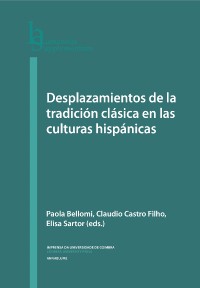Please use this identifier to cite or link to this item:
https://hdl.handle.net/10316.2/44011| Title: | Lo sagrado y los seres mitológicos en la Enciclopedia de maravillas de Laureano Albán: el caso de Quirón y Pegaso | Other Titles: | The sacred and the mythological beings in the Enciclopedia de maravillas by Laureano Albán: the case of Chiron and Pegasus | Authors: | Campos López, Ronald | Keywords: | Costa Rican poetry;Laureano Albán;the sacred;Chiron;Pegasus;poesía costarricense;Laureano Albán;lo sagrado;Quirón;Pegaso | Issue Date: | 2018 | Publisher: | Imprensa da Universidade de Coimbra | Journal: | http://hdl.handle.net/10316.2/44002 | Abstract: | The lyrical subject of the Encyclopedia of Wonders of the Costa Rican poet
Laureano Albán evokes two mythological beings belonging to the Hellenic tradition:
Chiron and Pegasus. The lyrical subject establishes with them a dialectic regarding
the sacred and, consequently, the need to transcend the objective, conceptual and
desacralised (post)modern reality through poetry. The lyrical subject considers Chiron
and Pegasus as symbolical and mythical traces in pursuit of the sacred, for they present
a mythical, religious, creative or figurative content in face of the tremendous
and fascinating mystery of the sacred. On one side, in the poem “The Centauro”,
the mythical figure of Chiron reveals the endless wound of the homo religiosus to the
lyrical subject. It is the intuitive being’s profound desire to achieve a transcendental
and mystical knowledge amidst the profane reality, the tragic passing of time and the
feeling of loneliness. At this juncture, the Hellenic myth of Cronus is also evoked. On
the other hand, in the poem “The Pegasus”, the figure of this winged creature represents
the spiritual, existential and poetic elevation to the lyrical subject. It is because
the lyrical subject realises that he only relies on poetry for expressing the spiritual knowledge he has acquired through his daily experiences both in the world and in
his innermost. At the end, Chiron and Pegasus figures respectively materialise the
archetype of the ancient sage and the symbolism of spiritual elevation and refinement. En la Enciclopedia de maravillas del costarricense Laureano Albán, el sujeto lírico evoca a dos seres mitológicos de la tradición helénica: Quirón y Pegaso. Con ellos establece una dialéctica en torno al tema de lo sagrado y, por consiguiente, sobre las necesidades de trascender la realidad objetiva, conceptual y desacralizada de la (pos) modernidad por medio de la poesía. Para el sujeto lírico, Quirón y Pegaso son rastros simbólicos y míticos en la búsqueda de lo sagrado, ya que estos dos seres presentan un contenido mítico, religioso, mágico, creativo o figurativo, frente al misterio terrible y fascinante de lo numinoso. Por un lado, en el poema “El centauro”, la figura mítica de Quirón le revela al sujeto lírico la herida interminable del homo religiosus, ese deseo profundo del ser intuitivo por alcanzar un conocimiento trascendental y místico, en medio de una realidad profana, el devenir histórico y un sentimiento de soledad y angustia. En esta coyuntura, se evoca asimismo el mito helénico de Cronos. Por otra parte, en “El Pegaso”, la figura de esta criatura alada representa para el sujeto lírico la elevación espiritual, existencial y poética, porque este descubre que solo cuenta con la poesía para expresar el conocimiento espiritual que ha aprendido a través de sus experiencias cotidianas en el mundo y su espacio interior. Al final, las figuras de Quirón y Pegaso materializan el arquetipo del anciano sabio y el simbolismo de la elevación y perfeccionamiento espirituales, respectivamente. |
URI: | https://hdl.handle.net/10316.2/44011 | ISBN: | 978-989-26-1549-3 978-989-26-1550-9 (PDF) |
DOI: | 10.14195/978-989-26-1550-9_9 | Rights: | open access |
| Appears in Collections: | Desplazamientos de la tradición clásica en las culturas hispánicas |
Files in This Item:
| File | Description | Size | Format | |
|---|---|---|---|---|
| lo_sagrado_y_los_seres_mitologicos.pdf | 334.27 kB | Adobe PDF |  |
Items in DSpace are protected by copyright, with all rights reserved, unless otherwise indicated.
